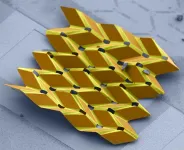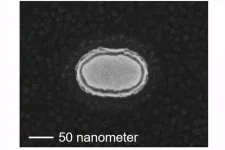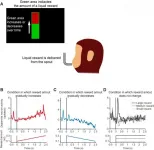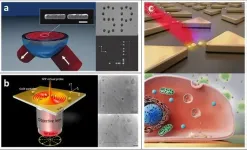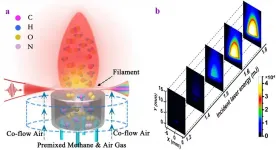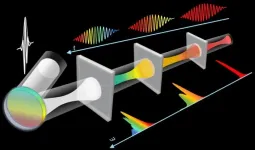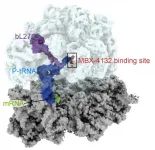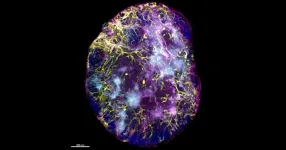(Press-News.org) RESEARCH TRIANGLE PARK, N.C. -- Army-funded researchers created nanosized robots that could enable locomotion, novel metamaterial design and high-fidelity sensors.
Cornell University researchers created micron-sized shape memory actuators that fold themselves into 3D configurations and allow atomically thin 2D materials with just a quick jolt of voltage. Once the material is bent, it holds its shape, even after the voltage is removed.
To demonstrate the technology, the team created what is potentially the world's smallest self-folding origami bird.
"The research team is pushing the boundary of how quickly and precisely we can control motion at the micro- and even nano-scales," said Dr. Dean Culver, program manager for Complex Dynamics and Systems at Army Research Office, an element of the U.S. Army Combat Capabilities Development Command, known as DEVCOM, Army Research Laboratory. "In addition to paving the way for nano-robots, the scientific advancements from this effort can enable smart material design and interaction with the molecular biological world that can assist the Army like never before."
The research may result in future applications 10 to 20 years from now, he said.
In a peer-reviewed article published in Science Robotics, researchers said this work could make it possible for a million fabricated microscopic robots releasing from a wafer to fold themselves into shape, crawl free, and go about their tasks, even assembling into more complicated structures.
"We humans, our defining characteristic is we've learned how to build complex systems and machines at human scales, and at enormous scales as well," said Prof. Paul McEuen, the John A. Newman Professor of Physical Science at Cornell University. "What we haven't learned how to do is build machines at tiny scales."
Micron-sized shape memory actuators could allow atomically thin two-dimensional materials to fold themselves into 3D configurations with just a quick jolt of voltage. Researchers create what is potentially the world's smallest self-folding origami bird.
This is a step in that basic, fundamental evolution in what humans can do, of learning how to construct machines that are as small as cells, he said.
The researchers ongoing collaboration has generated a throng of nanoscale machines and components, each seemingly faster, smarter and more elegant than the last.
"We want to have robots that are microscopic but have brains on board," said Prof. Itai Cohen, professor of physics at Cornell University. "That means you need to have appendages that are driven by complementary metal-oxide-semiconductor transistors, basically a computer chip on a robot that's 100 microns on a side. The hard part is making the materials that respond to the CMOS circuits."
This shape memory actuator developed by the research teams allows them to drive with voltage and make the materials hold a bent shape. The machines fold themselves fast-within 100 milliseconds. They can also flatten and refold themselves thousands of times and they only need a single volt to be powered to life.
"These are major advances over current state-of-the-art devices," Cohen said. "We're really in a class of our own."
Cornell researchers have created micron-sized shape memory actuators that enable atomically thin two-dimensional materials to fold themselves into 3D configurations. All they require is a quick jolt of voltage. And once the material is bent, it holds its shape - even after the voltage is removed. As a demonstration, the team created what is potentially the world's smallest self-folding origami bird.
These actuators can bend with a radius of curvature smaller than a micron-the highest curvatures of any voltage-driven actuator by an order of magnitude. This flexibility is important because one of the bedrock principles of microscopic robot manufacturing is that the robot size is determined by how small the various appendages can be made to fold. The tighter the bends, the smaller the folds, and the tinier the footprint for each machine. It's also important that these bends can be held by the robot, which minimizes the power consumption, a feature especially advantageous for microscopic robots and machines.
The devices consist of a nanometer-thin layer of platinum capped with a titanium or titanium dioxide film. Several rigid panels of silicon dioxide glass sit atop those layers. When a positive voltage is applied to the actuators, oxygen atoms are driven into the platinum and swap places with platinum atoms.
This process, called oxidation, causes the platinum to expand on one side in the seams between the inert glass panels, which bends the structure into its predesignated shape. The machines can hold that shape even after the voltage is removed because the embedded oxygen atoms bunch up to form a barrier, which prevents them from diffusing out.
By applying a negative voltage to the device, the researchers can remove the oxygen atoms and quickly restore the platinum to its pristine state. And by varying the pattern of the glass panels, and whether the platinum is exposed on the top or bottom, they can create a range of origami structures actuated by mountain and valley folds.
"One thing that's quite remarkable is that these little tiny layers are only about 30 atoms thick, compared to a sheet of paper, which might be 100,000 atoms thick. It's an enormous engineering challenge to figure out how to make something like that have the kind of functionalities we want," McEuen said.
The team is currently working to integrate their shape memory actuators with circuits to make walking robots with foldable legs as well as sheet-like robots that move by undulating forward. These innovations may someday lead to nanorobots that can clean bacterial infection from human tissue, microfactories that can transform manufacturing and robotic surgical instruments that are 10 times smaller than current devices, according to Cohen.
The team is also researching the principles that need to change in order to design, manufacture and operate machines at this scale.
INFORMATION:
In addition to ARO, the National Science Foundation, the Cornell Center for Materials Research, the Air Force Office of Scientific Research, and the Kavli Institute at Cornell for Nanoscale Science funded the work.
DEVCOM Army Research Laboratory is an element of the U.S. Army Combat Capabilities Development Command. As the Army's corporate research laboratory, ARL is operationalizing science to achieve transformational overmatch. Through collaboration across the command's core technical competencies, DEVCOM leads in the discovery, development and delivery of the technology-based capabilities required to make Soldiers more successful at winning the nation's wars and come home safely. DEVCOM is a major subordinate command of the Army Futures Command.
Infection with severe acute respiratory syndrome coronavirus 2 (SARS-CoV-2) in pregnancy is associated with preeclampsia, stillbirth, preterm birth and other adverse outcomes, found new research published in CMAJ (Canadian Medical Association Journal) .
"Our findings suggest that pregnant people with COVID-19 have an increased risk of high blood pressure, stillbirth and preterm birth. Their newborns are more likely to need intensive care. Pregnant people with severe COVID-19 symptoms have a particularly high risk of these complications," says Dr. Nathalie ...
An important function of the grant peer review process is to provide constructive feedback to applicants for their resubmissions. However, little is known about whether review feedback achieves this goal.
The American Institute of Biological Sciences (AIBS), in collaboration with Washington State University, has published findings on a multi-methods analysis of responses from grant applicants regarding their perceptions of the usefulness and appropriateness of peer review feedback they received from grant submissions.
The analysis focused on responses ...
Tohoku University researchers have, for the first time, developed the technology for the nanosecond operation of the spintronics-based probabilistic bit (p-bit) - dubbed the poor man's quantum bit (q-bit).
The late physicist R.P. Feynman envisioned a probabilistic computer: a computer that is capable of dealing with probabilities at scale to enable efficient computing.
"Using spintronics, our latest technology made the first step in realizing Feynman's vision," said Shun Kanai, professor at the Research Institute of Electrical Communication at Tohoku University and lead author of the study.
Magnetic tunnel junctions (MTJs) are the key component of non-volatile ...
Tsukuba, Japan - Animals must make predictions about future rewards when making decisions during daily life. Specific reward-related patterns of neuronal activity are known to underlie such decisions. But now, researchers from Japan have found a new pattern of neural activity that occurs when responding to rewards that are changing over time.
In a study published this month in eLife, researchers from the University of Tsukuba have revealed that dopamine neurons, which process information about rewards, are activated in a previously undetected way when an animal considers a reward that is changing in value.
Previous studies have highlighted ...
Optical tweezers and associated manipulation tools in the far field have had a major impact on scientific and engineering research by offering precise manipulation of small objects. More recently, the near-field manipulation with surface plasmons has opened opportunities not feasible with conventional far-field optical methods. The use of surface plasmon techniques enables excitation of hotspots much smaller than the free-space wavelength; with this confinement, the plasmonic field facilitates trapping of various nanostructures and materials with higher precision. It has become commonly used in trapping of micro- and nanometre-sized objects in various fields of science.
In a new review paper published in Light Science & Application, a team of scientists, led by Professor ...
Laser ignition (LI) is a promising electrode-less alternative to electronic spark ignition of lean fuel/air mixtures, offering high thermal efficiency with low harmful emissions. One of the most widely adopted LI methods is nanosecond laser-induced spark ignition (ns-LISI), in which combustible mixtures undergo multiphoton ionization followed by avalanche breakdown, resulting in high-temperature and high-pressure plasma along with shockwaves. However, inevitable shot-to-shot energy fluctuations resulting from ns light sources lead to the stochastic nature of the breakdown, influencing reaction routes and producing potential misfiring.
Although LI is not a new concept, it is commonly deemed that igniting lean-fuel mixtures by an ultrashort femtosecond (fs) ...
Generating intense ultrashort pulses with high spatial quality has opened up possibilities for ultrafast and strong-field science. It is so important that the Nobel Prize in Physics 2018 was given to Dr. Strickland and Dr. Mourou for inventing a technique called chirped pulse amplification, which drives numerous ultrafast lasers worldwide. With the great advancement in the last decade, Yb-based ultrafast lasers have become highly popular, because they exhibit exceptional thermal efficiency, are low in cost and are highly flexible in adjusting pulse energies and repetition rates. However, the pulse durations from these lasers are usually not shorter than 100 fs or even 1 ps, which requires external ...
UNIVERSITY PARK, Pa. -- A new antibiotic compound clears infection of multi-drug resistant gonorrhea in mice in a single oral dose, according to a new study led by researchers at Penn State and Emory University. The compound targets a molecular pathway found in bacteria but not humans and could lead to new treatments for gonorrhea and infections from other bacteria, such as tuberculosis and MRSA.
The research team, which also includes scientists from the biopharmaceutical company Microbiotix, the Uniformed Services University, and Florida State, published their results in a paper appearing March 19 ...
A new imaging technique is shining a light on immune responses and setting the scene for enhancing immune memory to optimise vaccine strategies.
By imaging intact lymphoid organs in three dimensions, researchers have been able to identify specialised niches, which can determine how immune T cells function.
The research, published in Nature Immunology, is a step forward in understanding the differentiation of T cells - critical cells for developing strong immune responses - and how we can use these crucial findings to inform and optimise vaccine strategies.
At a glance
Three-dimensional imaging has enabled researchers to identify the factors that play a role in determining where immune memory cells locate ...
Professor Chunghun Lim and his research team in the Department of Biological Sciences unveiled a neuroprotective pathway that suppresses Lou Gehrig's Disease (ALS).
Nucleocytoplasmic transport (NCT) defects have been implicated in neurodegenerative diseases, such as C9ORF72-associated amyotrophic lateral sclerosis and frontotemporal dementia (C9-ALS/FTD). In this study, the research team has identified a neuroprotective pathway of like-Sm protein 12 (LSM12) and exchange protein directly activated by cyclic AMP 1 (EPAC1) that sustains the nucleocytoplasmic ...
